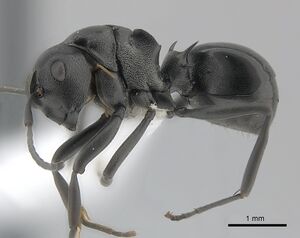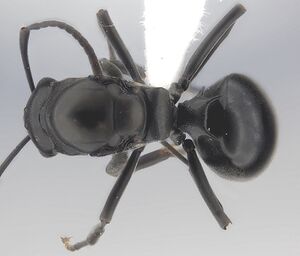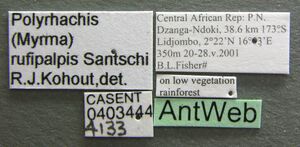Polyrhachis rufipalpis
| Polyrhachis rufipalpis | |
|---|---|

| |
| Scientific classification | |
| Kingdom: | Animalia |
| Phylum: | Arthropoda |
| Class: | Insecta |
| Order: | Hymenoptera |
| Family: | Formicidae |
| Subfamily: | Formicinae |
| Tribe: | Camponotini |
| Genus: | Polyrhachis |
| Subgenus: | Myrma |
| Species group: | militaris |
| Species: | P. rufipalpis |
| Binomial name | |
| Polyrhachis rufipalpis Santschi, 1910 | |
| Synonyms | |
| |
The extent of what is known about this species' biology is an eclectic set of observations. An arboreal species, nests are probably constructed of fibre. A solitary female caught in eastern Ghana was running on a tree trunk with several Polyrhachis fissa workers. A recently dealated female was recorded in Ghana in June. (Bolton 1973)
Identification
A member of the Polyrhachis militaris species-group. Bolton (1973) - A small, arboreal, active species, closest related to Polyrhachis alluaudi, differing from it in size and details of sculpturation.
Keys including this Species
- Key to Afrotropical Polyrhachis species
- Key to Afrotropical Polyrhachis species (Bolton 1973, OUTDATED)
Distribution
Latitudinal Distribution Pattern
Latitudinal Range: 6.206666667° to -2.283333333°.
| North Temperate |
North Subtropical |
Tropical | South Subtropical |
South Temperate |
- Source: AntMaps
Distribution based on Regional Taxon Lists
Afrotropical Region: Cameroun, Central African Republic, Congo (type locality), Democratic Republic of Congo, Ghana, Uganda.
Distribution based on AntMaps
Distribution based on AntWeb specimens
Check data from AntWeb
Countries Occupied
| Number of countries occupied by this species based on AntWiki Regional Taxon Lists. In general, fewer countries occupied indicates a narrower range, while more countries indicates a more widespread species. |

|
Estimated Abundance
| Relative abundance based on number of AntMaps records per species (this species within the purple bar). Fewer records (to the left) indicates a less abundant/encountered species while more records (to the right) indicates more abundant/encountered species. |

|
Biology
Castes
Worker
Images from AntWeb
   
| |
| Worker. Specimen code casent0403630. Photographer Estella Ortega, uploaded by California Academy of Sciences. | Owned by CAS, San Francisco, CA, USA. |

| |
| Worker. Specimen code casent0250037. Photographer Peter Hawkes, uploaded by Curator Peter Hawkes AFRC. | Owned by AFRC, Pretoria, South Africa. |
Queen
Images from AntWeb
   
| |
| Queen (alate/dealate). Specimen code casent0403444. Photographer Estella Ortega, uploaded by California Academy of Sciences. | Owned by CAS, San Francisco, CA, USA. |
Nomenclature
The following information is derived from Barry Bolton's Online Catalogue of the Ants of the World.
- rufipalpis. Polyrhachis rufipalpis Santschi, 1910c: 396 (w.) CONGO. Bolton, 1973b: 317 (q.). Combination in P. (Myrma): Wheeler, W.M. 1922a: 1000. Senior synonym of mayumbensis: Bolton, 1973b: 317.
- mayumbensis. Polyrhachis rufipalpis r. mayumbensis Forel, 1913h: 358 (w.) DEMOCRATIC REPUBLIC OF CONGO. Junior synonym of rufipalpis: Bolton, 1973b: 317.
Unless otherwise noted the text for the remainder of this section is reported from the publication that includes the original description.
Description
Worker
Bolton (1973) - TL 5.0-5.4, HL 1.26-1.29, HW 1.00-1.04, CI 78-82, SL 1.33-1.48, SI 133-142, PW 0.96-1.00, MTL 1.40-1.48. (7 measured.)
Anterior clypeal margin arcuate and entire. Eyes convex, the sides of the head in front of the eyes more or less straight and somewhat convergent anteriorly. Behind the eyes the sides round into the convex occipital margin. Alitrunk marginate laterally throughout its length, the margination interrupted only at the sutures. Constituent segments of dorsum of alitrunk transversely convex. Pronotum armed with a pair of spines, propodeum with a pair of variable teeth. Usually these are present as a pair of minute, upcurved denticles, but may be reduced to a pair of tubercles or even be absent. In one specimen a minute tubercle is present on one side but absent from the other. Promesonotal suture incised, metanotal groove impressed. In profile the propodeum rises vertically from the metanotal groove, passes through a strongly convex curve dorsally and then slopes backwards to the junction of the dorsum and the declivity. In dorsal view the marginations of the propodeum are slightly divergent posteriorly. Petiole with a blunt process ventrally, armed with four spines, the dorsal pair longer than the laterals, straight, directed slightly outwards and backwards. Lateral pair of spines directed outwards and very slightly upcurved. Anterior face of first gastral segment only very shallowly concave.
Body devoid of erect hairs except upon the anterior clypeal margin and the gastral apex. A fine pubescence present everywhere.
Sculpturation everywhere of a fine reticulation. Colour black, the tibiae lighter, brown to orange-brown, dully shining.
Queen
Bolton (1973) - As worker apart from the usual differences associated with caste.
Type Material
Bolton (1973) - Syntype workers, CONGO (Brazzaville): Brazzaville (A. Weiss) (Naturhistorisches Museum, Basel [examined].
References
- Bolton, B. 1973b. The ant genus Polyrhachis F. Smith in the Ethiopian region (Hymenoptera: Formicidae). Bulletin of the British Museum (Natural History) Entomology. 28:283-369. (page 317, queen described, Senior synonym of mayumbensis)
- Rigato, F. 2016. The ant genus Polyrhachis F. Smith in sub-Saharan Africa, with descriptions of ten new species. (Hymenoptera: Formicidae). Zootaxa 4088: 1–50.
- Santschi, F. 1910c [1909]. Formicides nouveaux ou peu connus du Congo français. Ann. Soc. Entomol. Fr. 78: 349-400 (page 396, worker described)
- Wheeler, W. M. 1922j. Ants of the American Museum Congo expedition. A contribution to the myrmecology of Africa. VIII. A synonymic list of the ants of the Ethiopian region. Bull. Am. Mus. Nat. Hist. 45: 711-1004 (page 1000, Combination in P. (Myrma))
References based on Global Ant Biodiversity Informatics
- Belshaw R., and B. Bolton. 1994. A survey of the leaf litter ant fauna in Ghana, West Africa (Hymenoptera: Formicidae). Journal of Hymenoptera Research 3: 5-16.
- Belshaw R., and B. Bolton. 1994. A survey of the leaf litter ant fauna in Ghana, West Africa (Hymenoptera: Formicidae). Journal of Hymenoptera Research. 3: 5-16.
- Bolton B. 1973. The ant genus Polyrhachis F. Smith in the Ethiopian region (Hymenoptera: Formicidae). Bulletin of the British Museum (Natural History). Entomology 28: 283-369.
- Fisher B. L. 2004. Diversity patterns of ants (Hymenoptera: Formicidae) along an elevational gradient on Monts Doudou in southwestern Gabon. Memoirs of the California Academy of Sciences 28: 269-286.
- IZIKO South Africa Museum Collection
- Rigato F. 2016. The ant genus Polyrhachis F. Smith in sub-Saharan Africa, with descriptions of ten new species. (Hymenoptera: Formicidae). Zootaxa 4088: 1-50.
- Robson Simon Database Polyrhachis -05 Sept 2014
- Santschi F. 1910. Formicides nouveaux ou peu connus du Congo français. Annales de la Société Entomologique de France 78: 349-400.
- Taylor B. 1978. Ants of the Nigerian Forest Zone (Hymenoptera: Formicidae). II. Formicinae, Dolichoderinae. Cocoa Research Institute of Nigeria Research Bulletin 5: 1-57.
- Wheeler W. M. 1922. Ants of the American Museum Congo expedition. A contribution to the myrmecology of Africa. VIII. A synonymic list of the ants of the Ethiopian region. Bulletin of the American Museum of Natural History 45: 711-1004

